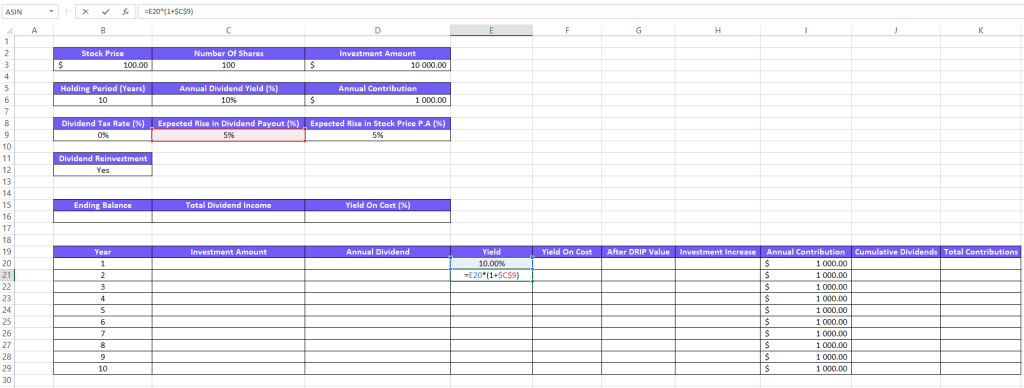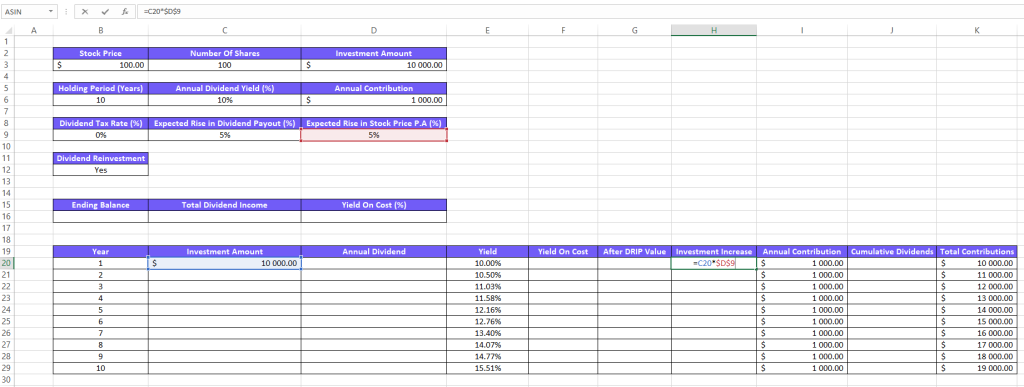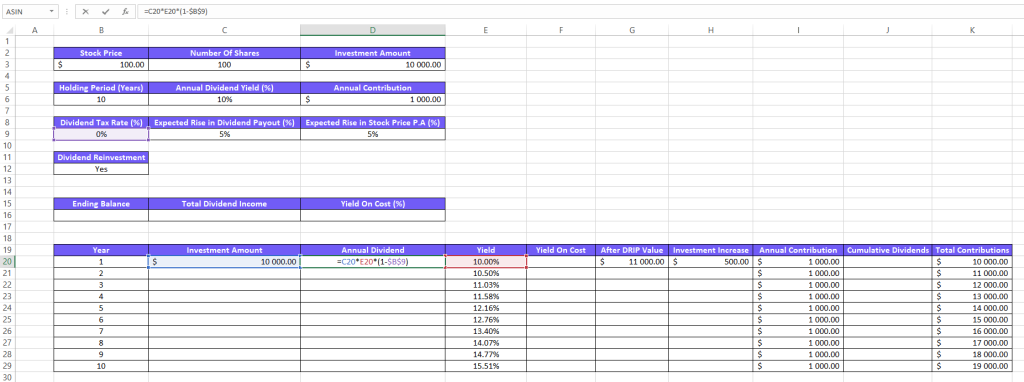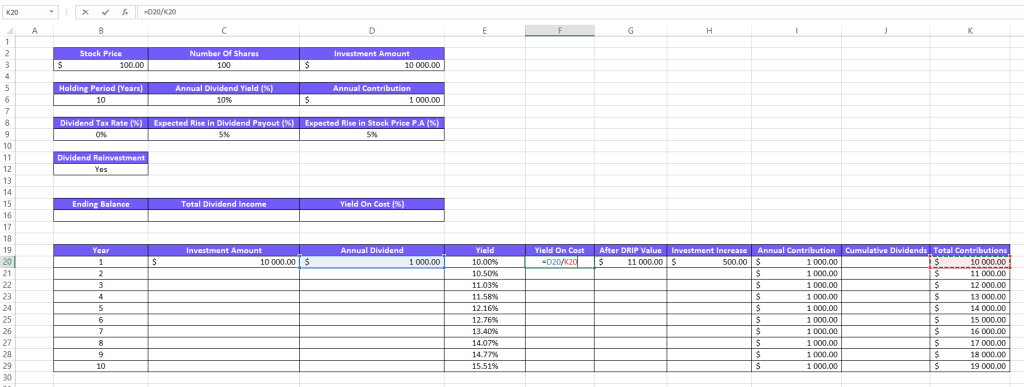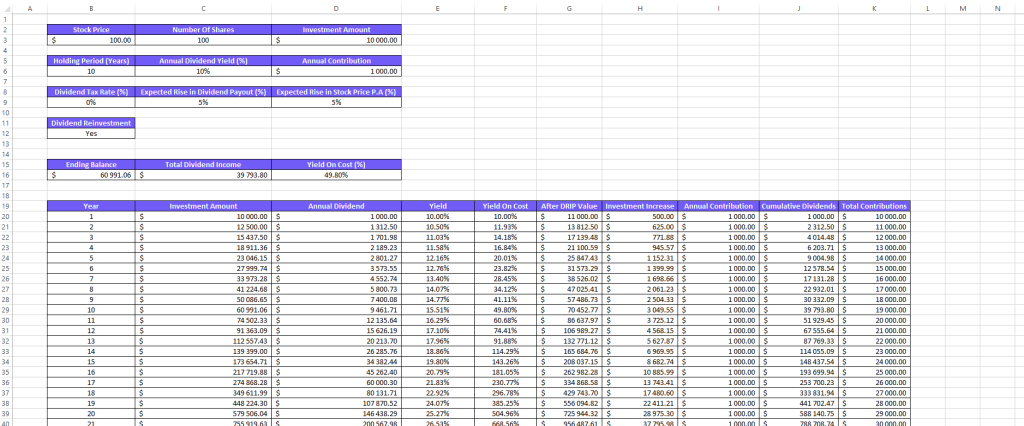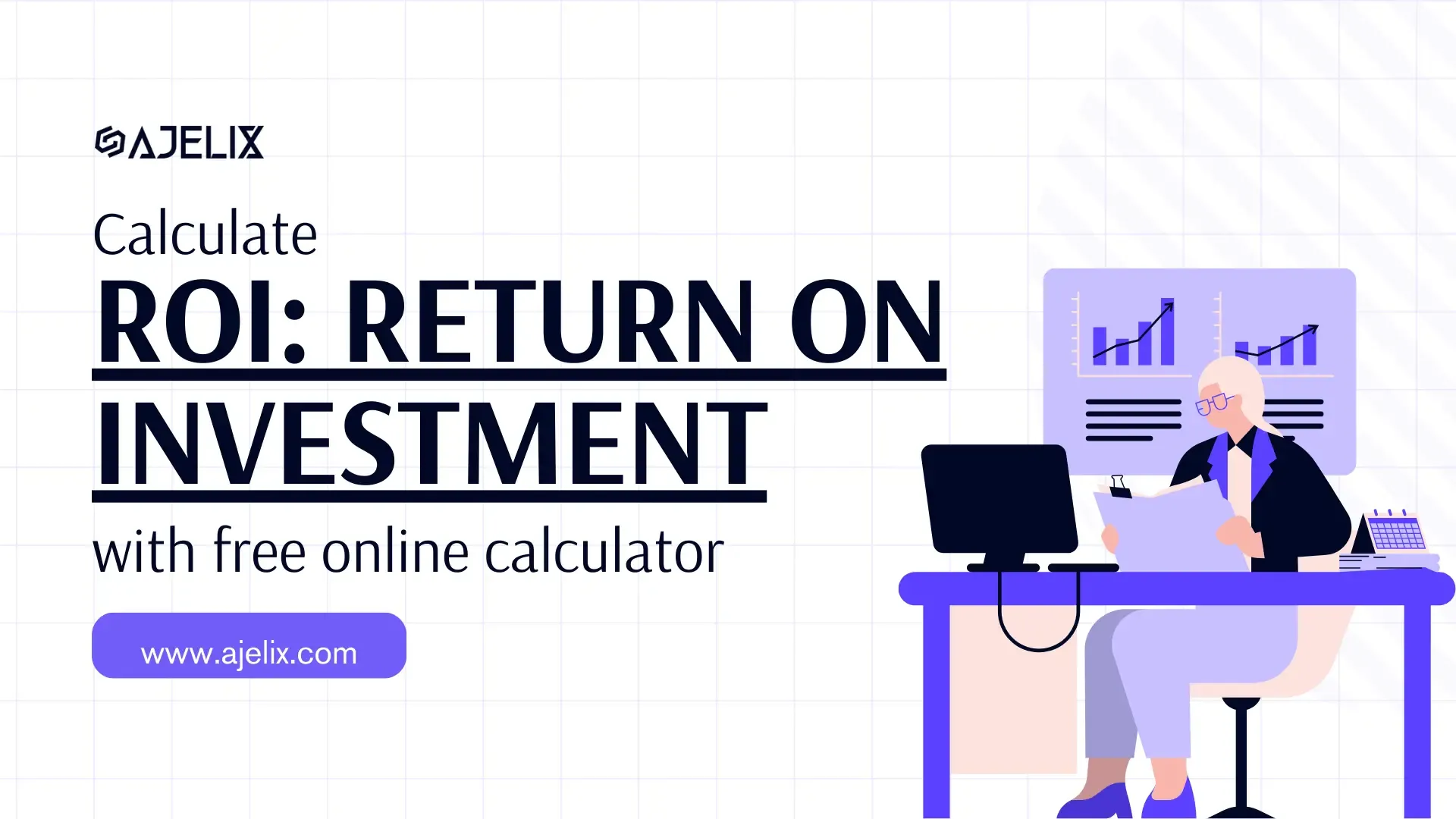- Home
- Data Visualization
- Tools
- AI Data Analyst
- Excel Formula Generator
- Excel Formula Explainer
- Google Apps Script Generator
- Excel VBA Script Explainer
- Excel VBA Script Generator
- Excel VBA Code Optimizer
- Excel VBA Code Debugger
- Google Sheets Formula Generator
- Google Apps Script Explainer
- Google Sheets Formula Explainer
- Google Apps Script Optimizer
- Google Apps Script Debugger
- Excel File Translator
- Excel Template Generator
- Excel Add-in
- Your Virtual AI Assistant For Excel Spreadsheets
- AI Answer Generator
- AI Math Solver
- AI Graph Generator
- AI SQL Generator
- Pricing
- Resources
- Home
- Blog
- Calculators
- Free Dividend Calculator Online: Calculate Investments
Free Dividend Calculator Online: Calculate Investments

Explore other articles
- 7 Productivity Tools and AI Plugins for Excel
- Top 5 Julius AI Alternatives for Data Analysis in 2025
- No Code Analytics: Business Impact and Top Tools in 2025
- Top Automation Tools for Excel in 2025: Built-In and Third-Party Solutions
- 5 Healthcare Data Analytics Trends 2025
- Which is the Best Analytics Platform for Startup Data Needs in 2025
- 13 Must-Have AI Tools for Startups in 2025
- 7 Best AI Tools for Excel Data Analysis (2025 Comparison)
- Why is AI-driven Data Intelligence the Key to Success?
- The Essential Role of AI in Conversational Analytics
Set up dashboard & track KPIs
A dividend calculator is a financial tool that helps investors figure out how much money they’ll get from stock dividends. It typically considers factors like the number of shares owned, current stock price, and dividend amount.
Dividend Calculator
Struggling with manual calculations?
Create KPIs and track your data regularly

Learn more
Fast registration and easy setup
What is a dividend?
A dividend is a portion of a company's profit that is distributed to its shareholders. It's essentially a way for the company to share its financial success with the people who own pieces of the company (the shareholders).
Here are some key points about dividends:
- Distribution of profits: Dividends are paid out of a company's earnings, not necessarily all of them. The company's board of directors decides how much profit will be distributed as dividends and how much will be reinvested in the business for future growth.
- Cash or stock: Dividends can be paid in cash, which is the most common form, or in additional shares of the company's stock.
- Not mandatory: There is no obligation for a company to pay dividends. Even if a company is profitable, it may choose to reinvest all its earnings back into the business.
- Tax implications: Dividends are taxed differently than capital gains (profits from selling stocks).
What is Dividend yield?
The dividend yield is a financial ratio that tells you the percentage of a company's share price that it pays out in dividends each year. It's a way to measure the income you'd receive from a stock's dividends relative to its current price.
Dividend yield formula
Dividend yield = (Annual dividend per share) / (Current stock price)
For example, let's say a company has a share price of $20 and pays a dividend of $1 per year. Its dividend yield would be:
Dividend yield = ($1 annual dividend) / ($20 current stock price) = 5%In this example, a 5% dividend yield means that for every $1 you invest in this company's stock, you'd earn $0.05 annually in dividends.
Here are some things to keep in mind about dividend yield:
- A higher yield generally indicates more income: A higher dividend yield typically suggests a larger portion of the share price is paid out as dividends. This can be attractive to investors seeking current income.
- Not the only factor to consider: A high dividend yield doesn't necessarily mean it's a good investment. The company's future growth prospects, financial health, and overall risk profile are also important factors to consider.
- Yield can change: Dividend yields can fluctuate over time as the company's stock price changes or its dividend payout policy evolves.
How To Calculate Dividend Income In Excel?
Calculate dividend income in Excel following this 17-step guide or download the Excel template with the dividend calculator at the bottom of the guide.
1. Create fields for variable values
Name the variable cells and input values for calculations:
- Stock price
- Number of shares
- Investment amount
- Holding period (years)
- Annual dividend yield (%)
- Annual contribution
- Dividend tax rate (%)
- Expected rise in dividend payout (%)
- Expected Rise in Stock Price P.A (%)
- Dividend reinvestment
2. Create a table for calculations
Name table headers for calculations with the following values:
- Year
- Investment Amount
- Annual Dividend
- Yield
- Yield on cost
- After DRIP value
- Investment increase
- Annual contribution
- Cumulative dividends
- Total contributions
3. Fill out the Year and Annual contributions columns
Fill out the first column "Year" with values depending on how many years you want to calculate dividends. For Annual contributions simply type =D6 (a variable field that contains annual contributions value), and press F4 to freeze this cell so you can drag down and fill out the table. Annual contributions usually don't change over the years, if they do, manually insert values.
4. Calculate the yield for each year
For the first year type the same yield you have in variables. For the next years calculate the expected rise in dividend payout, type formula =Annual Dividend Yield (%) *(1+Expected Rise in Dividend Payout (%))
5. Fill out the total contributions column
In the first row type the investment amount, in our example it's $10,000. For the next rows type formula: = Investment Amount + Annual Contribution
6. Calculate Investment increase
Fill out the first row for the "Investment amount" column, which in our example is $10'000. Then for the "Investment increase" column type formula =Investment Amount + Expected Rise in Stock Price P.A (%).
7. Calculate Annual Dividend
To calculate "Annual Dividend" use the formula =Investment Amount * Yield * (1-Dividend Tax Rate (%))
8. Calculate Yield On Cost
The next step to calculate dividend income is to get "Yield On Cost" values. To do that use this formula =Annual Dividend / Total Contributions
9. Fill out the Cumulative Dividends for 1 year
For the first year "Cumulative Dividends" will be the same as "Annual Dividend". Type =Annual Dividend 1 Year.
10. Calculate the Investment amount for the 2-year
Once you have calculated values for the 1 year, you can start filling out values for the second year. To get the Investment Amount for 2 years type this formula = After DRIP Value (previous year) + Investment Increase (previous year) + Annual Contribution
11. Fill out the Annual Dividend value for the 2-year
Once you have calculated the "Investment Amount" you can type the formula to get a 2-year "Annual Dividend" or you can drag down the formula from the previous year's calculation. Here's the formula =Investment Amount (2-year) * Yield (2-year) * (1-Dividend Tax Rate (%)).
12. Get Yield On Cost for the 2-year
To get the value for 2-year you can drag and fill the formula down from the previous year or use this formula =Annual Dividend (2-year) + Total Contributions (2-year).
13. Calculate the Drip Value for a 2-year
Again to get this value you can drag and fill the formula from the previous year or type this formula =Investment Amount (2-year) + Annual Dividend (2-year).
14. Calculate Investment Increase for 2-year
Repeat the actions from previous steps to get this value or type this formula =Investment Amount (2-year) * Expected Rise in Stock Price P.A (%).
15. Calculate Cumulative Dividends 2-year
To get the value for 2-year insert this formula =Cumulative Dividends (previous year) + Annual Dividend (the same year).
16. Fill out the values for the rest of the years
Now you have values and formulas for two years and you can easily fill out formulas for the next years gradually, like we did in the previous steps.
17. Find the total results for your investment plan
Once you have filled out the table for all years, you get the Ending Balance, Total Dividend Income, and Yield on Cost.

Download the Dividend Calculator in the Excel Template
Download your dividend investment Excel template below 👇
When are dividends paid?
The frequency of dividend payments varies depending on the company's dividend policy. Here's a breakdown of the common payment schedules:
| Frequency | Description |
|---|---|
| Quarterly | Most frequent payout schedule, providing consistent income throughout the year. |
| Semi-Annually | Dividends are distributed twice a year, typically in June and December. |
| Annually | Less frequent approach, with payouts happening just once a year. |
| Special | One-time dividend payment outside of the regular schedule. |
What are the Benefits of Owning a Dividend Stock?
There are a couple of key benefits to owning dividend stocks:
- Regular income: Dividend-paying companies share a portion of their profits with shareholders through regular payments. This provides investors with a steady stream of income, which can be used for living expenses, reinvesting in more stocks, or other purposes.
- Potential for compounding: When you reinvest your dividends to buy more shares of the same stock (or a different stock), you benefit from compounding. This means your returns are earned not just on your original investment, but also on any reinvested dividends. Over time, this compounding effect can significantly grow your wealth.
- Lower volatility: Dividend-paying stocks tend to be larger, more established companies with a history of profitability. These companies are generally less volatile than growth stocks, which can be more sensitive to market fluctuations. This can provide some stability to your portfolio during down markets.
- Hedge against inflation: Some companies also raise their dividends over time. This can help to offset the effects of inflation, which can erode the purchasing power of your money over time.
Here are some things to keep in mind about dividend stocks:
- Not all dividend stocks are created equal: A high dividend yield isn't always a good sign. It could indicate that the company is struggling to grow and is instead returning profits to shareholders. It's important to consider the company's overall financial health and future prospects before investing in a dividend stock.
- Dividends are not guaranteed: Companies can cut or suspend their dividends at any time. This can happen if the company's profits decline or if it needs to conserve cash for other purposes.
FAQ
Companies pay dividends to share profits with shareholders and incentivize them to hold onto the stock. It's a way to return some of the company's earnings to investors.
Several factors affect a company's dividend policy, including profitability, growth plans, and debt levels. Companies with strong profits may prioritize returning cash to shareholders through dividends, while growing companies may reinvest profits for future expansion. Debt levels can also impact dividends, as companies with high debt may need to prioritize debt repayment over payouts.
Dividends can be a reliable source of income but with some caveats. The payout is not guaranteed as companies can cut or suspend dividends anytime. A decline in the stock price can offset dividend income. Dividends are typically taxed, reducing your overall return.
Dividends are taxed differently depending on their type:
Qualified dividends: Generally taxed at a lower capital gains rate than ordinary income (potentially 0%, 15%, or 20%).
Ordinary dividends: Taxed at your regular income tax rate (up to 37%).
Companies typically pay dividends quarterly, meaning four times a year. However, some companies may pay them: semi-annually (twice a year), annually (once a year), or occasionally as a special dividend (outside the regular schedule).
Disclaimer: The information on this page is for educational purposes only and should not be construed as financial advice. While we strive to provide accurate information, investing involves inherent risks. Please consult with a qualified financial advisor before making any investment decisions.
Other calculators
Setup and monitor your KPIs regularly using Ajelix BI






